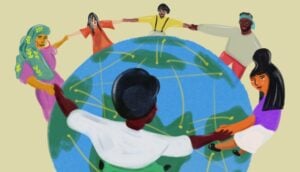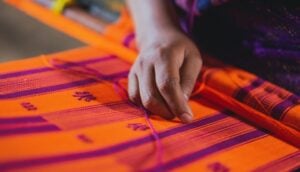One of the most difficult and underestimated hurdles to doing business in low-income markets is figuring out how products make their way from production to the final customer. In India, more than 90 percent of all retail purchases are made in 12 million kirana stores and in Mexico, more than 50 percent of retail business happens in about 800,000 changarros, tiny stores sometimes run from inside the house of the store owner. In many remote communities, people travel for miles to reach a store only to find it out of stock.
Navigating these often fragmented or non-existent distribution and sales networks is essential if companies and social enterprises want to reach and expand access to goods and services for the rapidly growing consumer market in developing countries.
Over the last few months, Business Fights Poverty has been working with a range of partners to understand how companies can build and scale models of inclusive distribution networks as part of the Inclusive Distribution Challenge. These models engage micro-enterprises and entrepreneurs at the base of the pyramid (BoP) in a way that expands opportunities and helps companies increase sales and reach new markets. Today we are publishing our preliminary findings in a discussion paper and are inviting practitioners and experts to join us as we explore specific solutions to the challenges of making inclusive distribution models scalable, successful business ventures.
The paper features three inclusive distribution models and 8 lessons for scaling these models. While these lessons apply across all three models, specific solutions can depend on the model. Here is a sneak peek at some of our findings:
1. A growing number of social enterprises and companies are developing direct salesforces for hard-to-reach, rural or urban communities. This includes some examples that have been operating for several years including Hindustan Unilever’s Shakti, Natura’s sales consultants, and Bata Shoe Company’s rural sales program. This model is also being employed by many social enterprises such as Chakipi in Peru and Haiti and Solar Sister in parts of Africa.
For this model to scale, there has to be a compelling value proposition for entrepreneurs to stay in the network and for companies to avoid costly turnover that can reach as high as 50 percent. This includes tangible value such as increased incomes, but also intangible benefits like new relationships and leadership opportunities. Unilever Shakti augments family income of Shakti Ammas by engaging male family members as Shaktimaans who sell products by bicycle in surrounding villages. Others like Living Goods focus on empowering its health promoters not only as entrepreneurs but also as community leaders. This has helped strengthen recruitment and retention rates. As many of these models engage women, they are also finding that scale requires a strong focus on overcoming key barriers to women’s economic empowerment including restrictive cultural norms and financial exclusion. Bata’s network in Bangladesh, in partnership with CARE International/Jita, has not only improved incomes but also enhanced self-esteem and shifted community perceptions to embrace marginalized women as entrepreneurs.
2. Given the important role that the traditional trade plays in many developing countries, a number of companies are pursuing models that leverage networks of existing micro-enterprises such as mom and pop shops or street vendors. AB InBev’s 4e Camino al Progreso, in partnership with FUNDES, aims to reach 190,000 shops in Latin America by 2020 with business and leadership skills training. Vodafone’s M-PESA depends upon 260,000 agents, mainly independent, formal businesses like pharmacies and convenience stores in ten markets.
A supportive policy environment is critical to scale these models. This includes efforts like streamlining the administrative process for formalization, increasing social security coverage, and providing incentives to help enterprises grow. One emerging example of how governments can support inclusive distribution is in South Africa where the government recently launched a program to empower and equip spaza shops with the necessary skills and equipment to run their businesses successfully. This program helped jump start a new partnership between Boloro, which offers spaza shops secure, merchant-initiated payments, and MobiCash. The partnership is being rolled out in late 2016 through Big Save Group, which is one of the largest wholesalers in the country, servicing tens of thousands of spaza shops.
3. Companies are also pursuing models that create or transform micro-enterprises into company-affiliated businesses or microfranchises. These networks are increasingly used in building materials or healthcare sectors where greater technical skills and higher standards are needed at the point of sale. Examples include LafargeHolcim’s Green Building Centers which are one-stop shops for housing expertise, building materials, and equipment for low-income consumers in India, as well as Pharmnet’s franchise network of more than 100 licensed private pharmacies in Kenya. In consumer goods, Mercado Fresco makes quality, affordable food accessible to low-income communities via stores located in the homes of a network of microfranchisees in Nicaragua.
Access to technology and finance for enterprises and consumers are critical to establish and grow these networks. In Nigeria, LafargeHolcim in partnership with development finance institutions, is providing housing microloans and coupling these loans with technical construction assistance for low-income borrowers, and connections to its network of reliable building materials retailers. One stakeholder told us that mobile technology was the most powerful evolution of their model because of the way it has lowered the cost of data collection and sped up performance management. Geocoding software, Whats app, and other mobile applications are helping companies make more efficient, and informed distribution and sales’ decisions that are empowering entrepreneurs and ultimately saving time and money.
This paper is intended to serve as a foundation for further investigation, dialogue, and collaboration to identify concrete solutions, test these in practice, and build partnerships to bring these models to scale. As Business Fights Poverty scopes out the next phase of the Challenge, it invites practitioners and experts to share their perspectives on how to unlock the power of downstream networks to strengthen enterprises, build sustainable livelihoods, and support business success.











One Response
Thanks , Jessica Davis Pluess. This is a good illustrations on Scaling Inclusive Distribution Networks where private sector ,development programs and practitioners (like us) can benefit a lot from this report
.